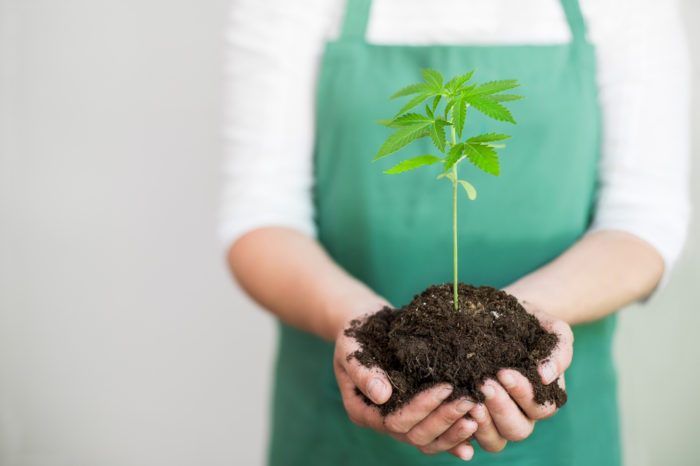Every cultivator should fine tune CO2 levels for growing cannabis.
Forty-five percent of dry plant matter comes from CO2. It’s a necessary component of photosynthesis, and without it, plants can’t efficiently convert energy into bountiful yields.
In cities, the average CO2 levels are around 400-500 PPM (parts per million). A study published by Atmospheric Chemistry and Physics (2017), [1]Verhulst, K. R., Karion, A., Kim, J., Salameh, P. K., Keeling, R. F., Newman, S., … Miller, C. E. (2017). Carbon dioxide and methane measurements from the Los Angeles Megacity Carbon Project … Continue reading measured carbon dioxide levels from the Los Angeles Megacity Carbon Project. Researchers found average annual CO2 levels to be 421 PPM. While such levels are sufficient for plant growth so long as the air circulates consistently, they don’t stimulate optimal growth. For that, astute gardeners will need to introduce some extra CO2 into the airtight space where the plants grow.
How Cannabis Plants Utilize CO2
All plants extract CO2 from the atmosphere through the stomates — the pores found in the epidermis of leaves, stems, and other organs, that facilitate gas exchange. Plants utilize the CO2 in conjunction with light, either artificial or natural, to produce oxygen and sugar. The sugar feeds plant growth, while the oxygen returns to the atmosphere.
By increasing CO2 levels in the grow room, and with sufficient accompanying light, plants will create more energy and grow faster, stronger, and more efficiently.

When to Increase CO2 Levels for Growing Cannabis
Cannabis plants only need CO2 when the lights are on, so levels should not be allowed to remain high with lights turned off. During the lights-off period, plants reverse their respiration cycle and take in oxygen via the top third of the root zone. CO2 levels in excess of 500 PPM when the lights are off will negatively affect the final yield. When the lights are on, cannabis plants can withstand CO2 levels of up to 1800 PPM.
Methods of Increasing CO2 Levels for Growing Cannabis
There are several methods of introducing CO2 into a cannabis grow. Purchasing compressed CO2 in bottles is one of the most effective ways to increase CO2 levels. In one pound of compressed gas, there are seven cubic feet of CO2.
Alternatively, gas regulators work with an attached airline that’s teed off at several points to introduce several emission sites. Growers can tie them to oscillating fans to ensure optimal exposure to the plants.
Another option is CO2 burners that consist of natural gas and propane. Here, one pound of burned fuel equates to three pounds of CO2. Finally, for the DIY enthusiast, an effective homebrew consists of a sugar, water, and yeast combo in a large five-gallon carboy fitted with a fermentation lock. While various methods exist, the most effective method of CO2 introduction is a CO2 bottle with an airline attached to an oscillating fan.
For those introducing CO2 into a garden with an exhaust system in place for cooling, it’s best to enrich CO2 levels with a burner as it’s the least expensive method. Place the burner on the intake side of the garden to ensure it travels through the garden before it is expelled. With a reliable and efficient source of CO2, the only remaining parameter to consider is measuring and maintaining CO2 levels.

Measuring and Calculating CO2 Levels for Growing Cannabis
To calculate the CO2 requirements of a grow room, cultivators will need to plug the dimensions of the room into the following equation: ((length x height x width) x 0.012) / cubic feet per hour of CO2 introduced x 60 = the number of minutes each hour to raise CO2 levels to 1600 PPM.
The above equation does not take into consideration the exhaust system that clears the air from the grow room. Without accurately measuring CO2 levels, growers will never know exactly how much CO2 is in the grow room. Dangers arise if the levels of CO2 increase to over 2000 PPM, at which point it’s toxic to both humans and cannabis plants alike. So, please don’t be the cultivator who passes out in the grow room from excessive CO2 levels.
Cultivators should ideally use a PPM monitor control to ensure optimal CO2 levels for growing cannabis. Such devices use infrared technology to monitor the PPM of CO2 and automatically adjust enrichment levels based on the requirements. Some even come with options to additionally control exhaust fans and heaters. They ensure consistent levels of CO2, and this is something that cannabis plants love.
Challenges Presented by CO2 Introduction
CO2 enrichment will cause the leaves to grow faster and larger, resulting in more plant matter. While this may sound hugely convenient, it brings with it its own set of problems. Faster growing plants require much more attention and maintenance in addition to extra nutrients and water. Plants that grow in a CO2 enriched environment that don’t receive the required extra levels of nutrients and water may become stunted.
In addition, any underlying issues already present in the grow room — like mold and pests — may be amplified significantly by ramping up CO2 levels. Garden space will also fill quickly, and cultivators will find themselves spending much more time in the garden as a result.
CO2 for Improved Yields
While it does involve extra cost, the benefits of CO2 enrichment for experienced growers are very real. With sufficient know-how and a small initial investment, yields may improve substantially.
References





